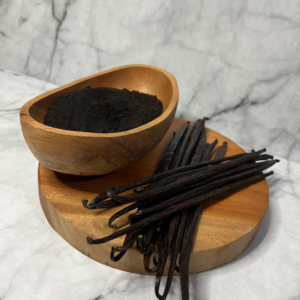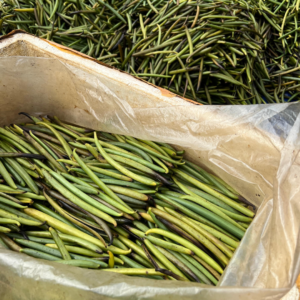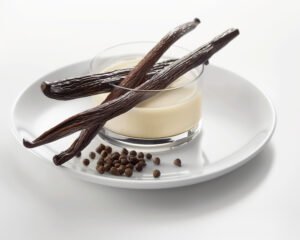
Vanilla (Vanilla planifolia) stands as one of the world’s most sought-after spices, often referred to as “black gold” due to its high cost and complex production process. Cultivating premium-quality vanilla involves meticulous care, extensive labor, and environmentally conscious agricultural practices. Indonesia is a major player in vanilla production, utilizing traditional methods and sustainable techniques to maintain high standards. By examining the vanilla supply chain, we can better understand its economic importance and the role of ethical sourcing in promoting sustainable growth.
Cultivating Vanilla: The Growing Process
Vanilla farming in Indonesia is predominantly carried out by smallholder farmers who rely on a blend of traditional knowledge and modern agricultural techniques. A critical step is manual pollination, as the vanilla orchid lacks natural pollinators outside its native regions. Farmers must hand-pollinate flowers within a short window to ensure pod formation.
The ideal conditions for vanilla cultivation include adequate shade, high humidity, and nutrient-rich soil. Many farmers incorporate agroforestry systems, intercropping vanilla with other plants to enhance biodiversity and improve soil quality. Sustainable farming practices such as natural composting and biological pest control are widely adopted to protect the environment while ensuring high bean quality. These methods help sustain the long-term viability of vanilla farming while meeting global demand for premium products.
Processing Vanilla: From Bean to Market

Following harvest, vanilla beans go through a comprehensive curing process to develop their signature aroma and flavor. The main steps include:
- Harvesting: Beans are handpicked at peak ripeness to ensure optimal vanillin content.
- Blanching: Brief exposure to hot water halts ripening and activates enzymes essential for flavor development.
- Sweating: Beans are wrapped in cloth and stored in a warm, humid setting to promote fermentation.
- Drying: Over several weeks, the beans are dried under controlled conditions to preserve their aromatic properties.
- Conditioning: Beans are stored in wooden containers for months to allow flavors to mature and intensify.
- Grading and Sorting: Beans are classified based on factors such as moisture content, size, and quality before being prepared for export.
Each step is essential to producing the deep, rich flavor profile that defines high-quality vanilla.

Indonesia’s Contribution to the Global Vanilla Industry
Indonesia is a key exporter of vanilla, supplying industries such as food, cosmetics, and pharmaceuticals. Vanilla farming provides vital income for many rural communities, contributing significantly to local economies.
However, the vanilla industry faces challenges, including price volatility, climate variability, and competition from synthetic alternatives. To address these challenges, Indonesian farmers and exporters are increasingly pursuing direct trade partnerships and certifications for fair trade and organic production, which help improve livelihoods and promote sustainable farming.
End Uses of Vanilla: Its Journey to Consumers
Vanilla’s versatile flavor and aromatic properties make it a staple across various industries:

- Food and Beverages: Natural vanilla is prized for its ability to enhance baked goods, desserts, and gourmet foods.
- Fragrances and Cosmetics: Its warm, inviting scent is popular in perfumes, lotions, and skincare products.
- Health and Wellness: Research indicates that vanilla may offer antioxidant and antimicrobial properties, making it valuable in health-focused products.
Conclusion: Advancing Sustainable and Ethical Vanilla Production
Vanilla production is a highly labor-intensive process requiring expertise at every stage, from cultivation to export. The industry plays a crucial role in supporting smallholder farmers and rural communities. By choosing ethically and sustainably sourced vanilla, consumers can help foster fair wages, environmental conservation, and high-quality production.
Understanding the journey of vanilla from raw bean to finished product underscores the craftsmanship and dedication behind this treasured spice. As demand for natural vanilla continues to rise, investing in transparent and sustainable supply chains will help secure its future for generations to come.
Discover the story behind sustainably grown vanilla with Baharat Agri Indonesia, a trusted supplier of premium Indonesian vanilla. Explore our commitment to ethical sourcing, sustainable practices, and delivering the finest vanilla products. Visit our website today to learn more and experience the difference in quality firsthand!
Frequently Asked Questions (FAQs)
1. Why is vanilla so expensive?
Vanilla’s high cost is primarily due to its labor-intensive cultivation and processing. Every stage, from hand-pollination to curing and grading, requires significant manual effort, time, and expertise. Additionally, limited supply, unpredictable weather, and market fluctuations further drive up the price.
2. How is vanilla pollinated?
Vanilla flowers must be hand-pollinated because they lack natural pollinators in regions outside their native habitat. Farmers manually transfer pollen from the male part of the flower to the female part to ensure pod formation.
3. What are the differences between natural and synthetic vanilla?
Natural vanilla is derived from real vanilla beans and contains a complex mixture of flavor compounds, while synthetic vanilla is made from artificial vanillin, typically derived from wood pulp or petrochemicals. Natural vanilla offers a more nuanced and richer flavor.
4. How long does it take to grow and process vanilla?
It takes approximately 3-4 years for a vanilla vine to produce its first harvestable pods. After harvesting, the curing and conditioning process can take several months to develop the bean’s characteristic flavor and aroma.
5. Why is sustainability important in the Indonesia vanilla industry?
Sustainable practices help protect the environment and improve the livelihoods of farmers. Many producers are adopting organic methods and fair trade practices to meet global demand for ethically sourced products.
6. How can consumers support ethical vanilla production?
Consumers can support ethical production by purchasing vanilla products labeled as fair trade, organic, or sustainably sourced. These certifications help ensure better wages and working conditions for farmers while promoting environmental sustainability.


